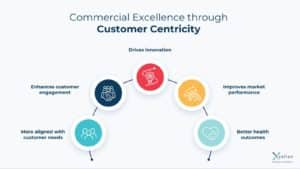Introduction
Traditionally, the pharmaceutical industry has been product-focused, prioritising the development and sales of medications. With growing competition, however, capturing the market with a product-centric approach is not feasible. Pharma companies are realising the need to create more value for the customers beyond products. Given the increasing importance of value-based care and growing expectations of patients and HCPs (health care providers) the industry is shifting towards customer centricity.
What is customer centricity?
Customer centricity in the most general sense refers to a strategic approach where the primary focus is on the needs and preferences of customers in every aspect of the business. This involves understanding their expectations and incorporating this understanding into product development, marketing, and overall business operations.
Studies have shown that companies that prioritise customer needs experience significantly faster revenue growth compared to their market rivals. Not only that, but customer-centric organisations also tend to achieve higher profitability. A large-scale global study found that 84% of organisations focusing on improving customer experiences boosted their revenue, while 79% realised significant cost savings(source: Forbes.com).

Implementing Customer Centricity in Pharma
Implementing customer centricity in the pharmaceutical industry first involves understanding and defining what it means for the company and the industry as a whole. In the pharma industry, it primarily means redefining their engagement models to capture more value for and with HCPs and in turn their patients.
To successfully transition into a customer-centric model, companies need to focus on three main aspects:
Personalization: Tailoring interactions and offerings to meet the specific needs of individual customers.
Engagement: Actively involving customers in the decision-making process and maintaining open lines of communication.
Empathy: Understanding and addressing the emotional and practical needs of customers.
By embracing these principles, pharmaceutical companies can create more meaningful and beneficial relationships with their customers, ultimately leading to better health outcomes and business success.
Here’s a breakdown of how companies can begin to build a customer-centric approach and pave the way for commercial excellence:
Identify Customer Needs and Expectations:
The first step in achieving customer centricity is to thoroughly understand the needs and expectations of various customer segments. This involves collecting data through surveys, focus groups, social media listening, and direct customer feedback.
Segment Your Customer Base:
Once you have gathered data, segment your customer base into distinct groups based on their specific needs, preferences, and behaviours. This segmentation allows for more targeted and personalised interactions.
Leverage Data Analytics:
Utilise data analytics to gain deeper insights into customer behaviours and preferences. Advanced analytics can help identify patterns and trends that inform more effective customer engagement strategies. Predictive analytics can also anticipate future needs and help tailor offerings accordingly.
Develop Customer-Centric Products and Services:
Use the insights gained from data analysis to develop products and services that meet the specific needs of your customer segments. This may include understanding the needs, challenges, and pain points of HCPs and patients, segmenting HCPs based on behaviour, preferences, and needs to create targeted engagement plans, personalised messaging etc.
Train and Empower Employees:
Ensure that all employees, especially those in customer-facing roles such as sales reps, are trained in customer-centric practices. Upskill them with data literacy, real-time coordination, personalised engagement strategies etc in order to prioritise customer needs and provide exceptional service.
Foster a Customer-Centric Culture:
Cultivate a company culture that places the customer at the centre of all business activities. This involves leadership commitment, clear communication of customer-centric values, and recognition of employees who exemplify these values.
Implement Feedback Mechanisms:
Establish channels for customers to provide feedback and ensure that this feedback is used to make continuous improvements. This could include regular surveys, feedback forms, and direct communication channels.
Monitor and Measure Success:
Regularly track and measure the effectiveness of your customer-centric strategies using key performance indicators (KPIs) such as customer satisfaction scores, net promoter score (NPS) etc. Use this data to refine and enhance your strategy.
Commercial Excellence through Customer Centricity
When companies understand and prioritise customer needs, they can streamline their operations to deliver more relevant products and services. This alignment reduces waste, improves resource allocation, and enhances overall efficiency. Moreover, customer-centric strategies foster deeper and more meaningful engagement with customers. This leads to stronger relationships, increased loyalty, and a higher likelihood of repeat business. Engaged customers are also more likely to provide valuable feedback that can drive continuous improvement. Positive customer experiences lead to word-of-mouth referrals and a stronger brand reputation, which can drive sales and market share.
Insights gained from customer interactions can inform the development of new products and services. By understanding unmet needs and pain points, pharmaceutical companies can innovate to create solutions that address these gaps, leading to a competitive edge in the market.
Ultimately, the goal of the pharmaceutical industry is to improve health outcomes. Customer-centric approaches ensure that treatments and services are more effective and aligned with patient needs, leading to better adherence and health outcomes. This success translates into commercial benefits, as payers and healthcare providers are more likely to support and revisit effective treatments.

Preparing for a Customer-Centric Future
The pharmaceutical industry is at a crucial inflextion point where enhancing customer value is imperative for success. Companies that clearly define customer centricity, invest in the right talent, upskill and explore new models will be better positioned to serve their customers and thrive in an increasingly competitive market. Furthermore, adapting to customer-centric models will require a strategic shift in culture, leadership, and operations across the industry.





